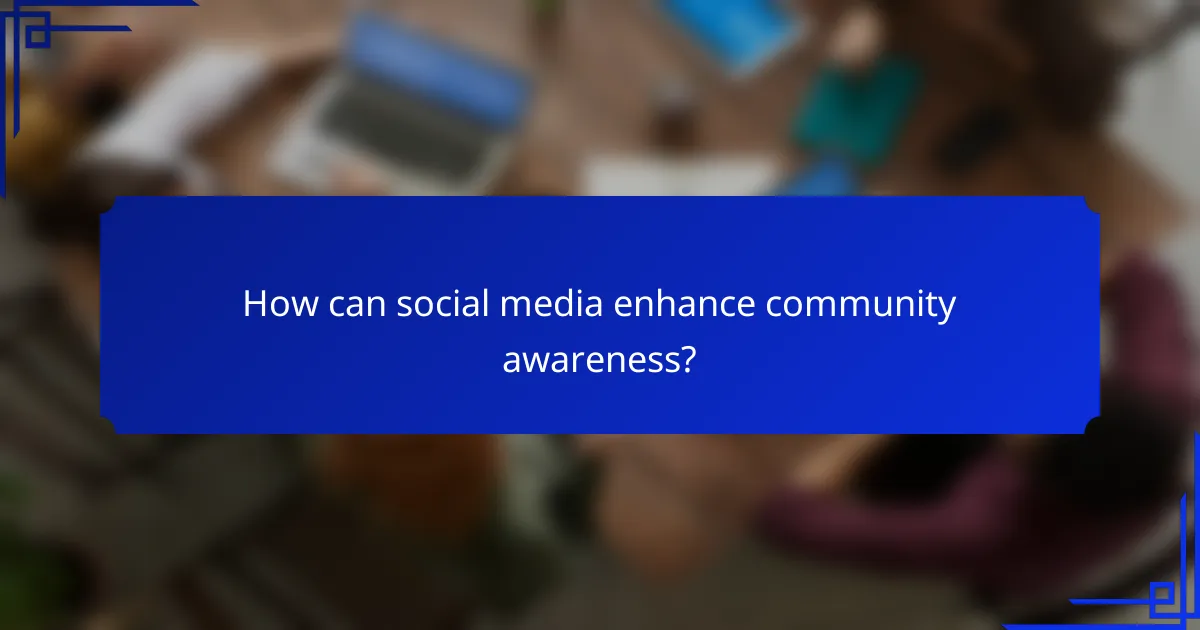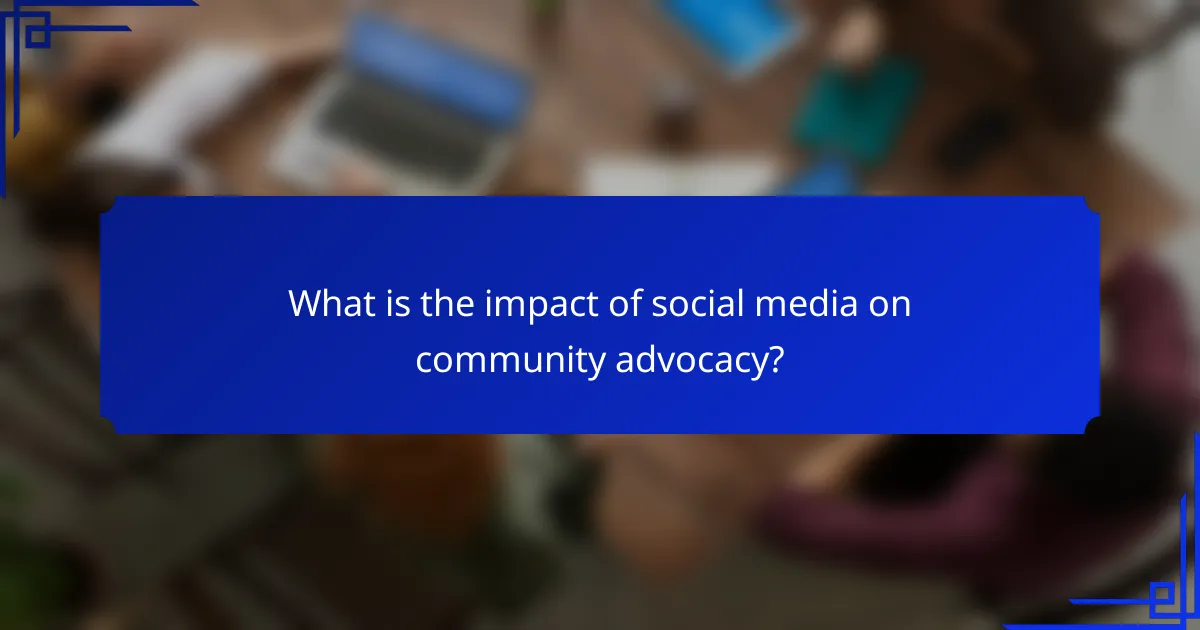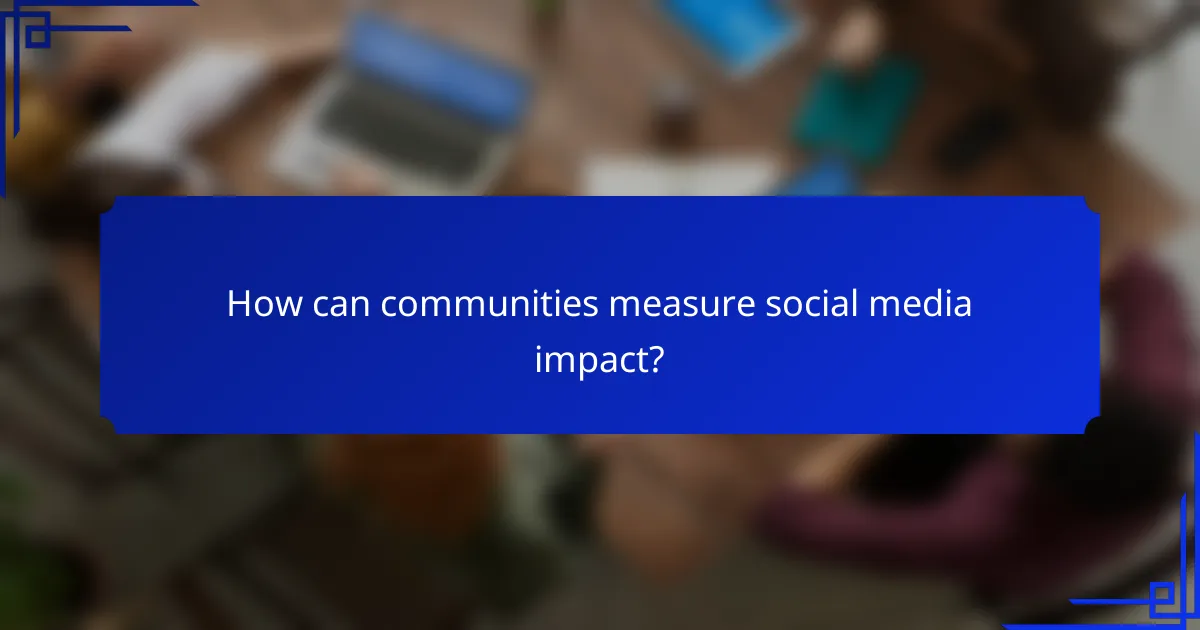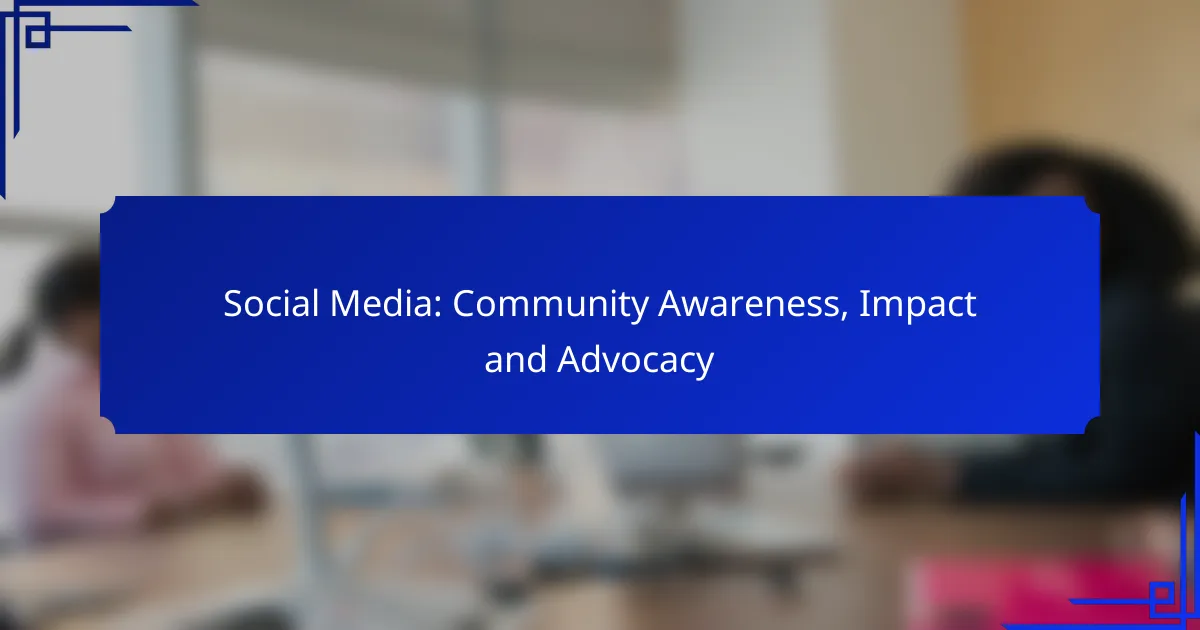Social media plays a crucial role in enhancing community awareness and advocacy by facilitating communication and engagement among residents. It allows individuals and organizations to share vital information, promote events, and mobilize support for local issues, ultimately driving collective action and fostering connections within the community.

How can social media enhance community awareness?
Social media can significantly enhance community awareness by facilitating communication and engagement among local residents. Through various platforms, communities can share information, promote events, and mobilize support for local issues effectively.
Increased engagement through local campaigns
Local campaigns on social media can boost community engagement by encouraging residents to participate in discussions and activities. For instance, a neighborhood cleanup initiative can gain traction through targeted posts and event pages, drawing in volunteers and fostering a sense of ownership.
Utilizing hashtags specific to the community can further amplify the reach of these campaigns, making it easier for residents to find and join in. Regular updates and interactive content, such as polls or challenges, can keep the community involved and motivated.
Real-time information sharing
Social media enables real-time sharing of information, which is crucial during emergencies or local events. For example, during a severe weather event, local authorities can quickly disseminate alerts and safety tips through platforms like Twitter or Facebook, ensuring residents remain informed.
Moreover, community members can share their own updates, creating a dynamic flow of information. This immediacy helps build trust and responsiveness within the community, as residents feel connected and informed about local developments.
Building local networks and support
Social media serves as a powerful tool for building local networks and support systems. Community groups can create dedicated pages or groups where residents can connect, share resources, and offer assistance to one another. This is particularly beneficial for vulnerable populations who may need additional help.
Additionally, local businesses can leverage social media to foster relationships with residents, promoting special offers or events that encourage community patronage. By engaging with local entities, residents can strengthen their ties and support one another, enhancing the overall community fabric.

What is the impact of social media on community advocacy?
Social media significantly enhances community advocacy by providing platforms for awareness, engagement, and mobilization. It enables individuals and organizations to share their messages widely, fostering connections and driving collective action on important issues.
Amplifying marginalized voices
Social media serves as a powerful tool for amplifying the voices of marginalized communities, allowing them to share their stories and experiences directly with a global audience. Platforms like Twitter and Instagram have been instrumental in raising awareness about social injustices, enabling users to highlight issues that may be overlooked by mainstream media.
For instance, hashtags such as #BlackLivesMatter and #MeToo have mobilized millions, creating a sense of solidarity and urgency around critical social issues. By sharing personal narratives and engaging in discussions, marginalized individuals can influence public perception and policy changes.
Mobilizing grassroots movements
Social media plays a crucial role in mobilizing grassroots movements by facilitating quick communication and coordination among supporters. Organizers can use platforms to announce events, share resources, and rally participants, often leading to significant turnout for protests and campaigns.
Examples include the Arab Spring, where social media was pivotal in organizing protests across multiple countries, and various climate strikes that have gained momentum through online engagement. To effectively mobilize, advocates should focus on clear messaging, utilize visual content, and encourage followers to share information within their networks.

How do organizations use social media for advocacy?
Organizations leverage social media for advocacy by engaging audiences, raising awareness, and mobilizing support for their causes. Through targeted campaigns, they can effectively communicate their messages, reach diverse demographics, and foster community involvement.
Case studies of successful campaigns
One notable example is the Ice Bucket Challenge, which raised awareness and funds for ALS research. Participants shared videos of themselves pouring ice water over their heads, encouraging donations and nominations, resulting in millions of dollars in contributions.
Another successful campaign is the #MeToo movement, which utilized social media to amplify voices against sexual harassment and assault. This grassroots initiative sparked global conversations and led to significant policy changes in various industries.
Tools for effective outreach
To enhance advocacy efforts, organizations can use tools like Hootsuite or Buffer for scheduling posts and analyzing engagement metrics. These platforms allow for streamlined content management and help track the effectiveness of campaigns.
Additionally, using graphic design tools such as Canva can assist in creating visually appealing content that captures attention. Engaging visuals can significantly increase shareability and reach across social media platforms.

What are the best practices for social media community engagement?
Effective social media community engagement involves building genuine relationships with your audience through meaningful interactions and relevant content. Best practices include creating authentic content and utilizing analytics for targeted messaging to ensure your efforts resonate with your community.
Creating authentic content
Authentic content reflects the true voice and values of your brand, fostering trust and loyalty among your audience. To create such content, focus on storytelling that resonates with your community’s experiences and interests, using relatable language and visuals.
Consider incorporating user-generated content, such as testimonials or photos from your followers, to enhance authenticity. This not only showcases real experiences but also encourages further engagement from your community.
Utilizing analytics for targeted messaging
Analytics play a crucial role in refining your social media messaging to better engage your community. By tracking metrics such as engagement rates, demographics, and content performance, you can identify what resonates most with your audience.
Use these insights to tailor your content strategy, focusing on topics and formats that drive interaction. Regularly reviewing analytics allows you to adapt quickly, ensuring your messaging remains relevant and impactful.

What challenges do communities face on social media?
Communities encounter several challenges on social media, including the spread of misinformation and online harassment. These issues can undermine trust, create divisions, and hinder effective advocacy efforts.
Addressing misinformation
Misinformation on social media can spread rapidly, leading to confusion and mistrust within communities. To combat this, community leaders should promote media literacy and encourage critical thinking among members.
One effective strategy is to verify information before sharing it. This can involve checking credible sources, cross-referencing facts, and using fact-checking websites. Communities can also create guidelines for identifying reliable information and share these resources widely.
Managing online harassment
Online harassment poses a significant threat to community engagement and safety. It can deter individuals from participating in discussions or advocating for important issues. Establishing clear community guidelines and reporting mechanisms can help address this problem.
Communities should foster a supportive environment by encouraging members to report harassment and providing resources for those affected. Additionally, promoting positive interactions and highlighting respectful communication can help mitigate the impact of negative behavior.

How can communities measure social media impact?
Communities can measure social media impact by analyzing engagement metrics, gathering feedback through surveys, and utilizing analytics tools. These methods provide insights into how effectively a community’s message resonates with its audience and drives action.
Engagement metrics and analytics
Engagement metrics include likes, shares, comments, and overall reach of social media posts. These indicators help communities understand which content resonates most with their audience. For example, a post with high shares may indicate strong community interest or support.
Analytics tools, such as Google Analytics or social media platform insights, can track user behavior and demographics. Communities should focus on key performance indicators (KPIs) like engagement rate and conversion rate to assess the effectiveness of their campaigns. Regularly reviewing these metrics allows for timely adjustments to strategies.
Surveys and feedback mechanisms
Surveys are a direct way to gather community feedback on social media initiatives. They can be distributed through social media channels or email, asking specific questions about community needs and perceptions. Aim for concise surveys with clear questions to encourage participation.
Feedback mechanisms, such as polls or comment sections, provide real-time insights into community sentiment. Communities should monitor these channels actively to gauge reactions and adapt their messaging accordingly. Combining quantitative survey data with qualitative feedback can create a comprehensive view of social media impact.
